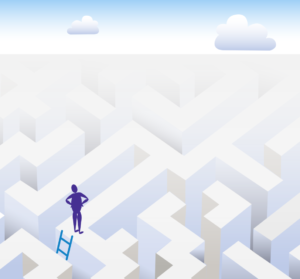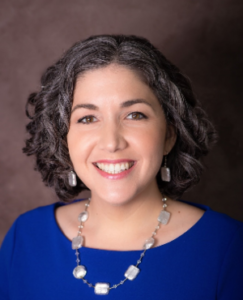 “Is my work making a big enough difference?” I’ve built a life around social justice work for the last 15 years, and this question has consistently challenged me. Burnout is a critical threat to people working exhaustive hours for dignity, security, and stability without seeing commensurate results. In the face of injustice, we must nurture belief in our ability to make positive change. When I was first trained as a community organizer, I learned the importance of building momentum through early wins. At Circles, participants use SMART (Specific, Measurable, Achievable, Realistic and Timebound) goals to make progress on their individual plan out of poverty. With a similar idea, Big View teams take actions–large and small–to address the systemic barriers that trap people in poverty.
“Is my work making a big enough difference?” I’ve built a life around social justice work for the last 15 years, and this question has consistently challenged me. Burnout is a critical threat to people working exhaustive hours for dignity, security, and stability without seeing commensurate results. In the face of injustice, we must nurture belief in our ability to make positive change. When I was first trained as a community organizer, I learned the importance of building momentum through early wins. At Circles, participants use SMART (Specific, Measurable, Achievable, Realistic and Timebound) goals to make progress on their individual plan out of poverty. With a similar idea, Big View teams take actions–large and small–to address the systemic barriers that trap people in poverty.
In Part One, I described the conceptual framework of the Big View: a grassroots “task force” that empowers Circles chapters to pursue systemic change. Testimonials from Circles participants and volunteers revealed how Big View activities develop confidence toward self-advocacy and civic engagement. Plus, we shared a dialogue process that’s ready for use in your communities.
We Build Policy Platforms
To inspire Circles chapters to think big, Circles USA published a poverty-reduction platform with policy recommendations at the local, state, and national levels. This platform, authored by Board Chair Joan Kuriansky, addresses six issues our chapters flagged as high priority: quality jobs, the “cliff effect,” broadband access, healthcare, housing, and transportation. Critically, the platform also lays out Circles USA’s commitment to addressing the structural biases that unjustly affect people of color and other historically marginalized communities.
Since publishing the policy platform, chapters have reported Big View milestones on additional topics. At the headquarters, we’re continuing to harvest learning from all of these efforts for the network’s benefit.
We Tackle Issues
Here are some examples of issues being explored in the Circles network.
Quality jobs — Circles Dorchester County, MD interviewed local manufacturers, trade contractors, and hospitality companies to locate the best job opportunities for residents experiencing poverty. They also interviewed job seekers to understand the obstacles limiting entry-wage workers. Based on this research, Circles Dorchester County recently launched its first cohort of participants, which aims to provide more intentional support for professional success in the region’s top industries. Many chapters–such as Circles Greenville County, SC–promote entrepreneurship as well, empowering Circles participants to start their own businesses.
The “cliff effect” — More than a dozen Circles chapters are piloting the use of tools from our two major partners. The Federal Reserve Bank of Atlanta created an online dashboard and planner to help individuals compare different job pathways and create a long-term budget for overcoming the cliff effect. The Leap Fund created a coaching program and a calculator for recipients of public benefits to determine if they will hit a cliff, when it will happen, and how long it will take to recover.
Broadband access — Circles Carbon County, UT helped their participants challenge a local utility company that was charging exorbitant late and reconnection fees. Other chapters have organized laptop donations during COVID and provided tech support to help families join weekly Circles virtual meetings.
Healthcare — Circles Campaign of the Mid-Ohio Valley, WV hosted an online candidates’ forum on healthcare. Circles participants were empowered to ask questions and offer feedback on politicians’ policy platforms. Meanwhile, several chapters advanced the regional focus on public health by growing community gardens that expand access to fresh produce.
Housing — Circles Salt Lake, UT helped in the creation and passing of the “truth in renting” bill, which protects renters from being ambushed by hidden fees that weren’t disclosed at the time they signed a lease and requires landlords to disclose up front any restrictions against renting to people with criminal records or poor credit histories before pocketing the application fees. Circles Laurel Highlands Region, PA discovered that banks won’t give loans to potential builders because of the limited infrastructure (water, sewage, etc.) in their rural area; Circles participants are testifying to policy makers and community leaders to communicate the need for affordable housing. Some Circles chapters have also connected participants to COVID-related government funds for eviction protection.
Transportation — Circles West Orange, FL was concerned about kids crossing at an unsafe intersection on their way to school, so participants learned how to work with the City Police Department to have a crosswalk installed. Several chapters are also pursuing stop-gap measures, such as bike-sharing and carpooling, to increase Circles participants’ access to reliable transportation.
Predatory lending/credit restoration — Circles Troup County, GA developed a program for Circles participants to pay off predatory loans with unreasonable interest rates. The Chapter initiated a partnership with CenterState Bank to enable Circles participants to borrow up to $750 to pay off their high-interest loans. The loans negotiated through CenterState have an interest rate of 4.5% and no “loan origination” fees.
We Share Our Stories
From early wins to lasting systemic change, Circles chapters are removing the barriers that trap people in poverty. To increase visibility for this work, let’s create a compendium of Big View actions in the Circles network! To be included in Circles USA’s forthcoming publication, click here to access the questionnaire via Google Docs for your written responses. If you’d prefer to be interviewed, please email jamie@circlesusa.org.
Thanks in advance for your contributions, Jamie Haft, Circles USA Executive Director


“Someone I love is experiencing poverty; what can I do?” This was a question at the heart of my personal life when I first encountered Circles USA. I had witnessed how someone could work so hard but still not overcome the many barriers to financial security, from catastrophic medical bills to workplace discrimination. This experience strengthened my conviction that we must address the root causes of poverty that hurt the people we love. The Circles model showed me how to carry this conviction into action. Our chapters help families get out of poverty and remove the barriers that get in the way. Most important is that the lived experiences of poverty–our stories, memories, and hard-learned lessons–shape the approach to change. One of my priorities, as executive director, is to further document the many ways that Circles chapters are pursuing systemic change in their communities.
We Take the Big View
Each Circles chapter has a Big View Team to tackle systemic change. This team includes community members drawn from government, schools, nonprofits, businesses, and philanthropies. Circles participants with first-hand knowledge of poverty share their perspectives to shape immediate, practical solutions as well as policy change.
Each Big View Team:
– Analyzes the service gaps and systems barriers that limit economic mobility. (For example: How is limited access to a bus route keeping Circles participants from job interviews, and what can we do to change that?) – Builds community capacity for civic engagement. (What is preventing Circles participants from voting in the upcoming local election, and how can we prove to them that their vote matters?) – Raises awareness of the issues. (How can we amplify the voices of Circles participants in dialogue with those in the community who have inherent biases against people experiencing poverty?) – Engages local, state, and federal elected officials. (Which politicians can advance specific change on this issue? How do we mobilize them?) – Implements a community-driven action plan to achieve measurable change (What are our short-term and long-term goals?)
We Advocate For Ourselves—and Each Other
Whether we promote voter education, testify to government officials, or work with city planners to grow infrastructure, participants develop the skills to tackle a multitude of barriers to economic security. Once participants grow their confidence in advocating for themselves, there is no end to the issues they can tackle.
”Being a part of a Town Hall meeting with three U.S. Representatives has given me a newfound confidence in the way the system works,” said Bonita Thomas, former Circles participant and now staff at Circles West Orange in Florida. “I feel like my voice was heard. I believe this gave the Representatives a look at the people that are on the ground being impacted by the decisions they make.”
Circles volunteers likewise benefit from participation on their Big View Team. As volunteer Sandi Wallace from Circles West Orange reflected: “Having an opportunity to teach Circles participants about the electoral process and to provide information about candidates and issues required me to do more homework than ever before. I was way more engaged in the election this year, and I know that others from Circles were more engaged too. The information shared at Big View meetings helped us feel informed and empowered to vote. Increasing voter education and turnout reinforces in me the belief that Circles is benefiting our whole community.”
We Engage in Dialogue
To inspire community deliberation, Circles USA recently published a template for research and analysis on seven different issues that typically affect families experiencing poverty: quality jobs, broadband access, healthcare, housing, transportation, childcare, and credit/lending. Key questions posed include: When it comes to this issue, what are the needs of people experiencing poverty? What alternatives are available? What workarounds are people using? In what ways will solving this issue benefit the community? Do participants know the current policies related to this topic? How can we leverage this collective knowledge to find potential solutions?
Designed by Jenny Lipfert, all seven of these slide deck templates are available for use in your communities. Click here to download.
In Part Two, we feature Big View examples from across the country. Plus, there’s an invitation to share your story for a forthcoming publication.
With excitement about the work ahead,
Jamie Haft, Circles USA Executive Director
